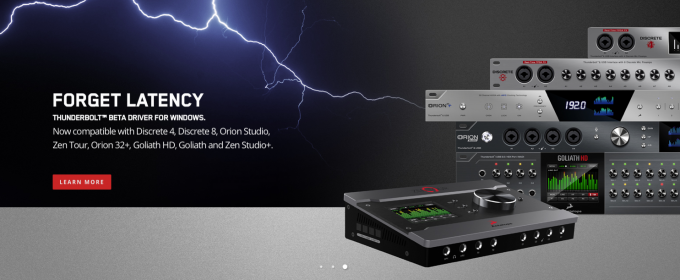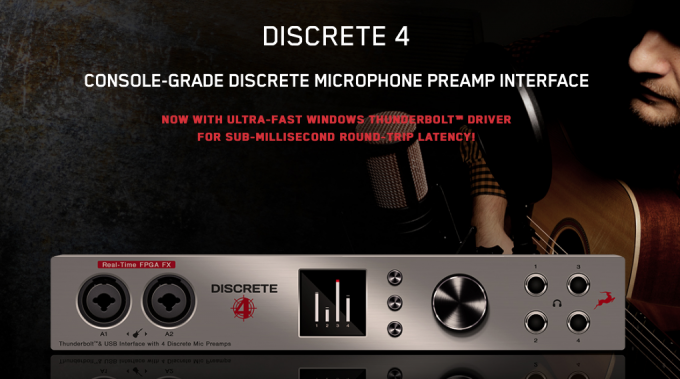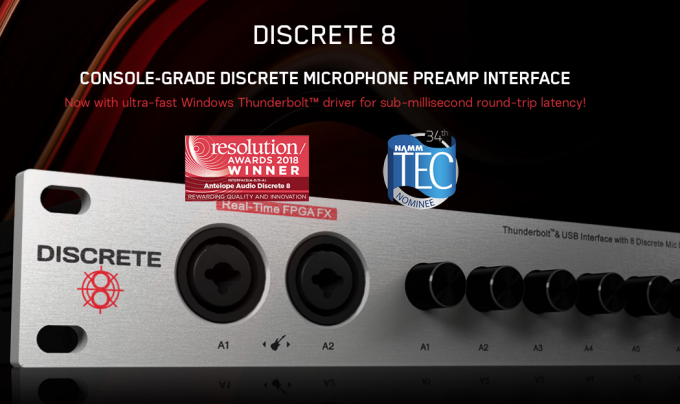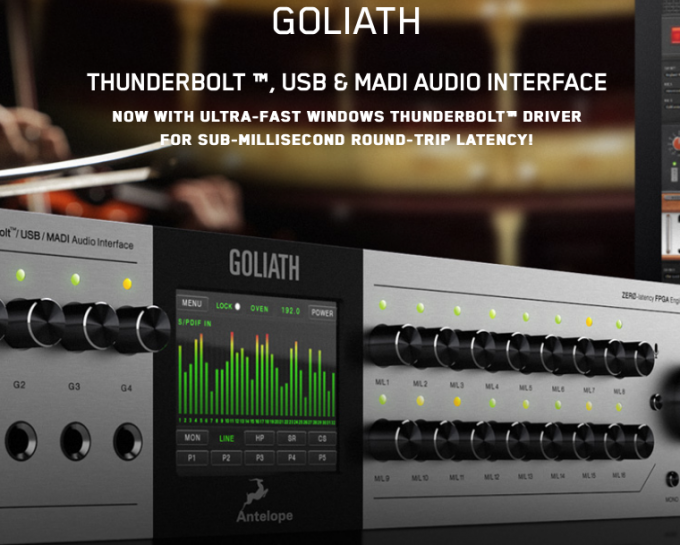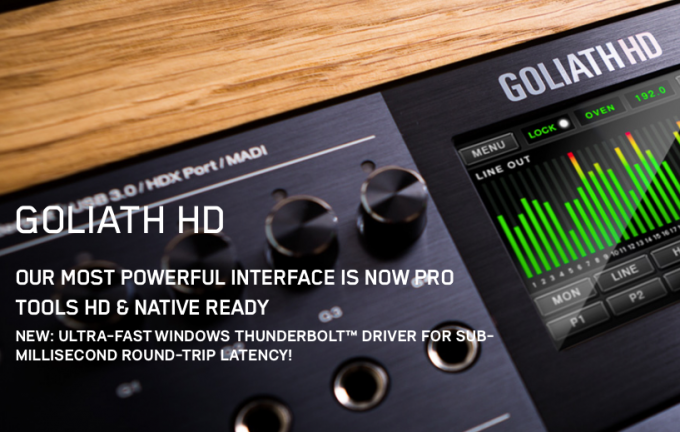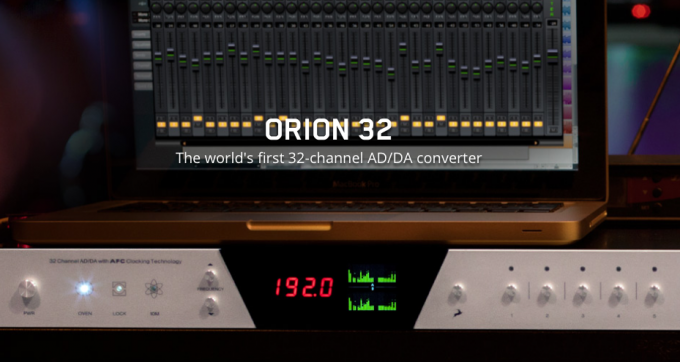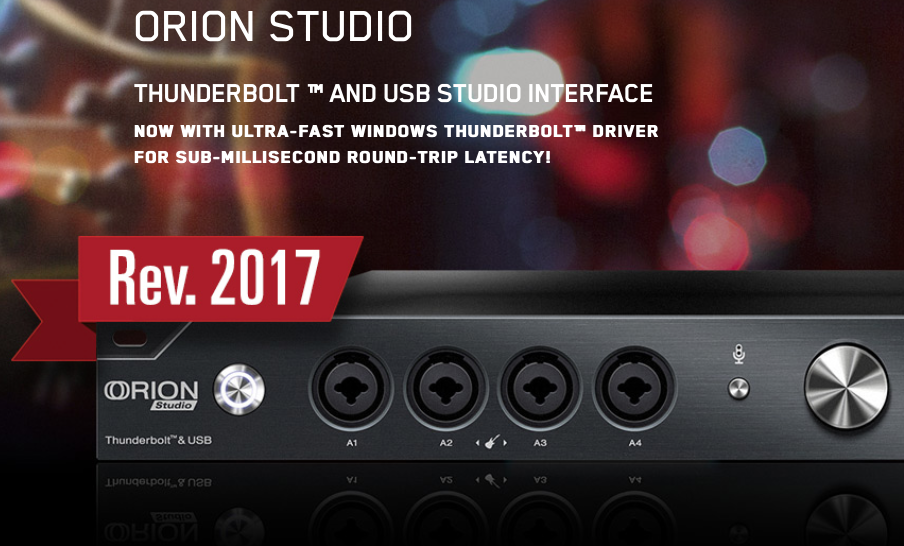Antelope Audio – Premium Interfaces with Next-Gen DSP
Posted on Mon 10 December 2018 in entries
Antelope Audio are a high-end manufacturer of DSP-enabled audio interfaces, mic pre-amp’s, converters, clocks and modelling microphones. They have been at the top of their game for two decades, and have a fantastic range of products that cater for artists, studios, broadcast, and live sound. Championing state-of-the-art FPGA technology, Antelope audio interfaces sport on-board lightning-fast DSP and come with a suite of real-time vintage and modern DSP plug-ins..
There was once a time when computers were not powerful enough to process audio in real time. Even now, there can be a limit to the amount of ‘native’ processing a computer can handle, and if it can handle it, will often require higher latencies to keep the system running smoothly.
One way to combat this issue is by using dedicated DSP hardware to offload the number-crunching to a separate processor. Over the years, there have been some great products that use this technique - the Korg Oasys PCI card, TC Electronic’s Powercore, SSL Duende, and Universal Audio UAD to name a few. Most have these have fallen by the wayside as computers have become more powerful to allow much more ‘native’ processing.
However, Antelope Audio have taken this idea one step further, and run their DSP code on a specialist processing chip called a ‘Field Programmable Gate Array’ or ‘FPGA’. These little chips are unlike traditional DSP chips (eg. SHARC chips) because they can do thousands of computations simultaneously, rather than one after another. For the audio world this is ideal, as there are always hundreds of calculations required every millisecond. More tracks and plug-ins running means more processing is needed. It stands to reason that an FPGA chip can handle this type of processing better due to its ‘parallel’ architecture.
The Antelope Audio interface range at first seems quite confusing, with variations on models in different families. There are four families – Discrete, Orion, Goliath and Zen.
Antelope Audio Discrete
The Discrete interfaces are designed for artists and home studios that are looking for the best possible audio quality. There are two basic versions – the Discrete 4 and Discrete 8. They both include Antelope’s FPGA DSP and plug-ins, rock-solid digital clocking, and thunderbolt/USB2, but vary in their audio connectivity.
The Discrete 8 sports eight console-grade 6-transistor mic pre’s, 8 line outputs (on a db25 connector), monitor output, two headphone outputs, spdif, 2x ADAT and 1x Word Clock in / 3 Word Clock out. Additionally, there are two re-amping outputs for sending signals back to guitar amps that can then be re-recorded.
Its little brother, the Discrete 4, has 4 mic pre’s and 4 line outs, and does away with the re-amping outputs, has only 1x ADAT, and Word Clock i/o is reduced to two outputs.
Both versions include the AFX plug-ins running on an FPGA chip, and these can be used inside the Discrete mixer for monitoring or as DAW effects using the AFX2DAW plug-in. These affects can be upgraded to ‘Premium’ for more vintage outboard emulations, or the units can be purchased with the Premium plug-ins from the outset.
All features of the Discrete interfaces can also be accessed from the unit itself, or via iOS or Android app’s.
Antelope Audio Goliath
The Goliath range, as the name suggests, is a bit of a monster when it comes to i/o and connectivity, and there are two flavours to choose from. These units have been designed for professional applications where high channel counts and a variety of audio signals need to be processed and routed with maximum versatility.
Goliath
The Antelope Audio Goliath is a 64 channel Thunderbolt, USB3 and MADI interface with 16 mic preamps, 2x re-amping outputs, 4x instrument DI’s, 2x headphone outs, 2x stereo inserts and integrated talkback.
Goliath boasts 36 analogue inputs and 32 analogue outputs in total, and a plethora of digital connections – MADI, AES, ADAT and SPDIF. Control over the i/o and parameters is made simple by dedicated front panel controls, a multi-coloured touch screen, a Mac/PC control panel, and iPad/Android apps.
Goliath HD
Similar to the standard Goliath, but with two DigiLink Mini connectors designed for Pro Tools HDX compatibility. Pro Tools studios that want to take advantage of Goliath’s versatile i/o and DSP, should consider the Goliath HD as an upgrade to their HDX system.
Other i/o differences to the Goliath are:
32 line outputs (on db25) instead of 24
8 channels of AES inputs and outputs instead of 16
64 channels on USB3 rather than 32 channels over USB2
Antelope Audio Orion
The Orion range comes in five different flavours, depending on your requirements. These 1U rackmount units also use Antelope’s proprietary FPGA processing and rock-solid clocking, and can be used as standalone interfaces, or as additional i/o for larger audio systems in live and studio applications.
Orion 32 / Orion 32 + / Orion 32 HD
The Orion 32 sub-family have (you’ve guessed it) 32 inputs and 32 outputs, plus a monitor output The main differences are in data connectivity.
Orion 32 Line level AD/DA and master clock with USB3 and MADI
Orion 32 + Like the original Orion 32, but with added Thunderbolt.
Orion 32 HD No Thunderbolt, but includes USB3 and HDX used by Pro Tools HD systems
Orion Studio / Orion Studio HD
Designed more as a ‘complete studio solution’, the Orion Studio models include mic preamps, DI inputs, headphone outputs, and inserts.
Orion Studio (rev 2017)
The Antelope Audio Orion Studio sports 12 mic preamps (4x with DI input), 16 line outputs (on db25), 2x stereo monitor outputs (switchable), 2x headphone outputs and 2x re-amping outputs.
Digital connections include 2x ADAT i/o and SPDIF i/o, 1x Word Clock in and 1x Word Clock out.
Data connection to the computer is over Thunderbolt (32 channels) or USB2 (24 channels).
Orion Studio HD
You’ve probably got the plot by now...
The Orion Studio HD is similar to the Orion Studio, but compatible with Pro Tools HDX and loses the thunderbolt connection.
Antelope Audio Zen
The Zen range is designed for portability and aimed at artists who want a top-quality DSP-enabled recording system connected over thunderbolt (32 channels) or USB2 (24 channels).
Zen Tour
The only ‘desktop’ unit in the Antelope range, the Zen Tour sports 8x analogue inputs (4x line/hi-z, 4x mic/line on rear), 8x line outputs (db25 connector), plus 2x switchable monitor outputs, 2x headphone outputs and 2x re-amp outputs. Digital connections include 2x ADAT and SPDIF, but no Word Clock.
The touchscreen control gives instant access to the Zen Tour controls, as does the MAC/PC control panel or the tablet/smartphone app.
The Zen Tour is ideal for home studio recording, and can be expanded via the ADAT connections for bigger projects.
Zen Studio +
The Antelope Audio Zen Studio Plus is a different form factor to the Zen Tour, but still portable enough to take on location.
Analogue i/o includes 12x mic preamps with inserts on channels 1 and 2, and 8x line inputs (db25). Outputs include 8x line outs (db25), monitor output, 2x headphone outputs and 2x re-amp outputs.
Digital connectivity of 2x ADAT allows expansion for larger projects, plus there’s SPDIF, Word Clock in and Word Clock out.
